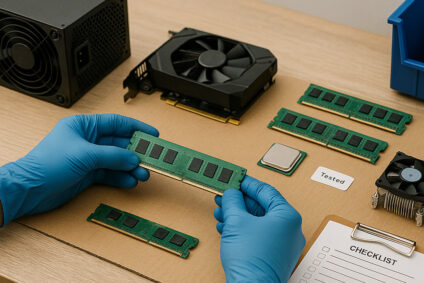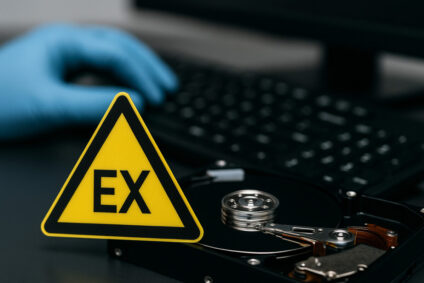What Is Data Sanitization—and Why Should You Care?
Data sanitization is more than just deleting files or formatting a drive. It’s the process of permanently and irreversibly removing data from storage devices, ensuring it cannot be recovered or misused. For companies retiring IT assets—especially hard drives, SSDs, or magnetic tape like LTO and 3592—it’s a regulatory requirement, a cybersecurity best practice, and an ethical obligation.
Unfortunately, many businesses believe they’re doing it right—until a data breach, legal demand, or failed audit proves otherwise.
The Dangerous Myth of “Delete and Forget”
Let’s get one thing straight: deleting data doesn’t mean it’s gone. Without verified sanitization methods, deleted files can be recovered with basic software tools. That means your trade secrets, customer records, or financial documents could still be sitting on that old drive you thought was wiped clean.
Common Missteps Include:
-
Using outdated deletion software with no audit trail
-
Trusting third-party vendors without verifying their methods
-
Ignoring compliance frameworks like NIST 800-88, HIPAA, or GDPR
Would your current data handling process stand up to a legal inquiry or a compliance audit? If you’re unsure, it may be time for a serious review.
The Three Accepted Methods of Data Sanitization
Per the NIST 800-88 Rev. 1 guidelines, there are three core methods to sanitize data, each appropriate for different use cases:
-
Clear – Overwrites existing data using non-sensitive patterns. Ideal for internal reuse of media.
-
Purge – Uses degaussing or cryptographic erasure to make data nearly impossible to recover.
-
Destroy – Physically destroys the media (e.g., shredding, crushing), typically used when reuse isn’t possible.
Each method has its place, but not all offer the same level of auditability and security. Physical destruction, while effective, often lacks the documentation needed for compliance.
Why Physical Destruction Isn’t Always the Best Option
It’s easy to assume that shredding a drive or tape is the most secure choice. But that’s not always the case.
-
Some tape shredders fail to destroy long formats like LTO-8 or 3592-JF properly.
-
Physical destruction eliminates reuse, contributing to growing e-waste.
-
No digital audit trail means no proof of compliance.
In short, if you can’t prove it, you didn’t sanitize it.
The Gold Standard: Certified, Auditable Software-Based Erasure
At WeBuyUsedITequipment.net, we use the Phoenix Certified™ Process, a fully auditable, standards-compliant approach to data sanitization. Here’s what sets us apart:
-
Compliance with NIST 800-88, ISO 27001, HIPAA, PCI DSS, and SOX
-
Support for a wide range of media: HDDs, SSDs, LTO-1 through LTO-9, and 3592-A through JF
-
Full audit trail including serialization, chain of custody, and digital logs
-
Certificates of sanitization for every device processed
We don’t just erase data—we document it, verify it, and stand behind it.

Real-World Risks of Getting It Wrong
Companies across industries have paid the price for poor data sanitization:
-
A healthcare provider was fined $1.25M after unencrypted patient data was found on discarded tapes.
-
A retailer’s old LTO tapes were accidentally sold online, exposing thousands of customer records.
-
A financial firm’s improperly wiped tapes leaked investor information when reused internally.
In each case, the company assumed their process was secure. The reality? It wasn’t.
Why In-House Wiping Falls Short
Trying to sanitize data in-house may seem like a budget-friendly move. But without certified tools, proper training, and verification protocols, the risk far outweighs the savings.
You could face:
-
Recoverable data left behind
-
Lack of audit logs or certificates
-
Noncompliance with regulatory frameworks
-
Costly legal or financial penalties
Can You Sanitize Older Tape Formats?
Yes—if you have the right tools and expertise. Our team can securely wipe even legacy media, from LTO-1 to LTO-4 and 3590 formats, and we’ll offer to buy those tapes after the wipe. That’s secure data erasure and value recovery in one step.
How to Know If a Data Wipe Was Successful
A successful wipe isn’t a matter of trust—it’s a matter of verification. We ensure:
-
Byte-for-byte data overwrite
-
Post-wipe readback testing
-
Tamper-proof audit logs
-
Certificates tied to serial numbers
Without these? You’re still at risk.
What Belongs in Your Data Sanitization Policy?
Your organization’s policy should align with R2v3, ISO 27001, and other data center compliant frameworks. At a minimum, it should cover:
-
Sanitization methods per media type
-
Documentation and retention of audit logs
-
Roles and responsibilities (internal team or vendor)
-
Proof of process (certificates, software logs)
Need help drafting or reviewing your policy? Our team can guide you.
Trust But Verify: Vetting Your Vendor
A certified recycler isn’t always a compliant one. Ask for:
-
Verification of tools used (e.g., NIST-compliant software)
-
Sample audit reports
-
Chain-of-custody documentation
-
Proof of certification (e-Stewards, ISO 9001, R2v3)
When it comes to data, blind trust is risky business.
Next Steps: Protect Your Data and Your Reputation
Don’t wait until it’s too late. Take proactive steps to protect your business:
-
Audit your current data sanitization process
-
Verify vendor compliance and documentation
-
Align your workflow with current regulatory standards
-
Schedule a risk-free assessment
We’ll inspect your current process, assess your tape or drive inventory, and offer secure, certified sanitization—plus buyback if applicable.
Get Started Today
Your data deserves better than guesswork.
📧 sales@webuyuseditequipment.net
🌐 www.webuyuseditequipment.net







